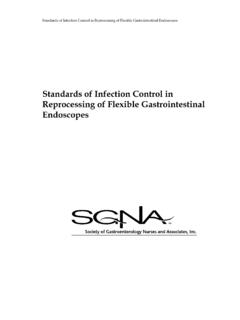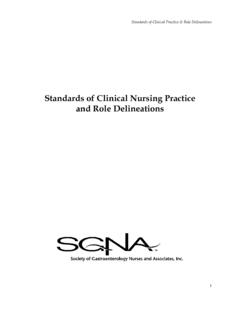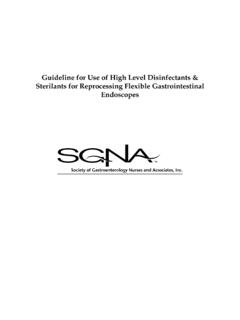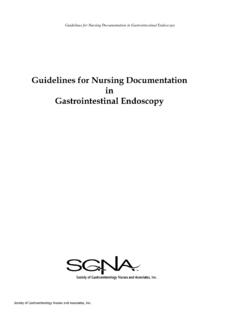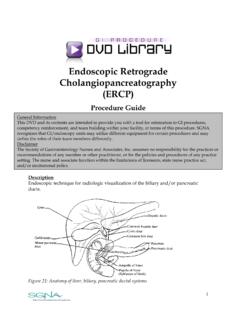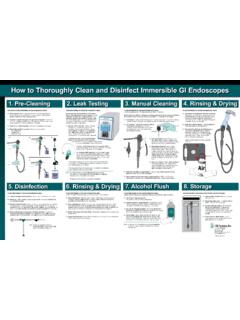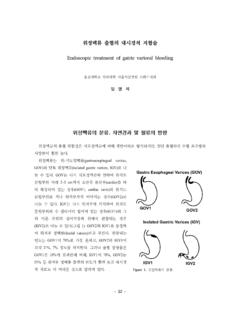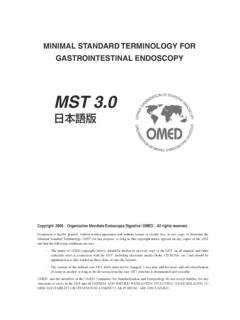Transcription of GIE SPECIAL ARTICLE - SGNA
1 GIE.. SPECIAL ARTICLE . Multisociety guideline on reprocessing exible GI endoscopes: 2016 update Prepared by: REPROCESSING GUIDELINE TASK FORCE. Bret T. Petersen, MD, FASGE, Chair, Jonathan Cohen, MD, FASGE, Ralph David Hambrick, III, RN, Navtej Buttar, MD, David A. Greenwald, MD, FASGE, Jonathan M. Buscaglia, MD, FASGE, James Collins, RN, Glenn Eisen, MD, MPH, FASGE. This ARTICLE was reviewed and approved by the Governing Board of the American Society for Gastrointestinal endoscopy (ASGE). The bene cial role of GI endoscopy for the prevention, for reprocessing GI ,2 Since then, high-level diagnosis, and treatment of many digestive diseases and disinfectants, automated reprocessing machines, low- cancer is well established.
2 Like many sophisticated medical temperature sterilization methods, endoscopes, and devices, the endoscope is a complex, reusable instrument endoscopic accessories have that requires meticulous cleaning and reprocessing in Additional outbreaks of infections related to suboptimal strict accordance with manufacturer and professional or- infection prevention practices during endoscopy ,8,9 lapses ganization guidance before being used on subsequent in endoscope reprocessing, contamination or malfunction patients. To date, published episodes of pathogen transmis- of automated reprocessing machines, and transmission sion related to GI endoscopy using standard end-viewing during ERCP have been well publicized.
3 A cluster of cases instruments have been associated with failure to follow es- of hepatitis C virus infection was attributed to grossly inap- tablished cleaning and disinfection/sterilization guide- propriate intravenous medication and sedation prac- lines or use of defective equipment. Recent reports ,89 In other instances, risk of infection transmission pertaining to transmission among patients undergoing has been linked to incorrect reprocessing as a result of un- specialized procedures using side-viewing duodenoscopes familiarity with endoscope channels, accessories.
4 And the with distal tip elevators have raised questions about the best speci c steps required for reprocessing of methods for the cleaning and disinfection or sterilization On-site ambulatory surgery center surveys con rm that of these devices between patient uses. gaps in infection prevention practices are In 2003 the American Society for Gastrointestinal Given the ongoing occurrences of endoscopy -associated endoscopy (ASGE) and the Society for Healthcare Epide- infections attributed to lapses in infection prevention, an miology of America collaborated with multiple physician update of the 2003 multisociety guideline was published and nursing organizations, infection prevention and in ,12,91 Now, after the recent experience with trans- control organizations, federal and state agencies, and mission by duodenoscopes despite appropriate reprocess- industry leaders to develop evidence-based guidelines ing practices.
5 An update to incorporate evolving information is again warranted. This update of the 2011 multisociety guideline retains Copyright 2017 by the American Society for Gastrointestinal endoscopy the expanded details related to critical reprocessing steps 0016-5107/$ of cleaning and drying and incorporates recent guidance that is speci c to those endoscope models with movable Volume -, No. - : 2017 GASTROINTESTINAL endoscopy 1. PGL DTD YMGE10269_proof 4 January 2017 9:12 pm Guideline update on reprocessing exible GI endoscopes Petersen et al elevators at the distal tip, such as duodenoscopes and was associated with a breach in currently accepted cleaning linear US endoscopes.
6 It also updates information on and disinfection guidelines, use of an unacceptable liquid those issues for which there are incomplete data to guide chemical germicide for disinfection, improper drying, or practice. These issues include endoscope shelf-life or defective equipment. In the subsequent 20 years, relatively hang time (the interval of storage after which endo- few additional reports of pathogen transmission during GI. scopes should be reprocessed before use), the role of endoscopy were published, and essentially all were associ- microbiologic surveillance testing of endoscopes after ated with clear lapses in either infection prevention prac- reprocessing, questions regarding endoscope durability tices or reprocessing of the endoscope and accessories.
7 And longevity from the standpoint of infection preven- Most recently, reports in both the medical literature and tion, and the evolution of various enhanced reprocessing general media have identi ed clusters of transmission of approaches for duodenoscopes. multidrug-resistant organisms during endoscopy with side-viewing duodenoscopes using mechanical elevators SPAULDING CLASSIFICATION FOR MEDICAL for device In contrast to prior episodes DEVICES AND LEVEL OF DISINFECTION of transmission, these outbreaks occurred despite appar- ently appropriate cleaning and HLD.
8 The details of these The classi cation system rst proposed by Dr E. H. episodes highlight the challenges with consistent clearance Spaulding divides medical devices into categories based of all organisms from the exposed, complex, moving parts on the risk of infection involved with their This and operating channels of duodenoscopes and the poten- classi cation system is widely accepted and is used by the tial role of bio lms in hindering adequate reprocessing. Food and Drug Administration (FDA), the Centers for Transmission episodes can generally be categorized as Disease Control and Prevention (CDC), epidemiologists, either nonendoscopic and related to care of intravenous microbiologists, and professional medical organizations to lines and administration of anesthesia or other medications help determine the degree of disinfection or sterilization or endoscopic and related to transmission by the endo- required for various medical devices.
9 Three categories of scope and/or accessories. medical devices and their associated level of disinfection are recognized: Nonendoscopic transmission of infection Critical: A device that enters normally sterile tissue or The importance of good general infection prevention the vascular system. Such devices should be sterilized, practices is highlighted by several outbreaks of hepatitis de ned as the destruction of all microbial life. Examples C, including 1 at a New York endoscopy center related to include endoscopes used in sterile settings such as lapa- improper handling of intravenous sedation tubing, multi- roscopic endoscopy and endoscopic accessories such as dose vials, and/or reuse of A similar cluster of biopsy forceps and sphincterotomes.
10 6 cases of hepatitis C infection occurred among patients Semicritical: A device that comes into contact with at a Las Vegas endoscopy These cases were intact mucous membranes and does not ordinarily attributed to cross-contamination from syringes reused to penetrate sterile tissue. These devices (eg, GI endo- draw additional doses of anesthetic from single-use vials, scopes) should receive at least high-level disinfection which were then used for multiple patients undergoing (HLD), de ned as the destruction of all vegetative mi- endoscopy . Surveillance testing was offered to over croorganisms, mycobacteria, small or nonlipid viruses, 40,000 patients of several af liated endoscopy centers medium or lipid viruses, fungal spores, and some, but that used these unsafe practices, the results of which not all, bacterial spores.
